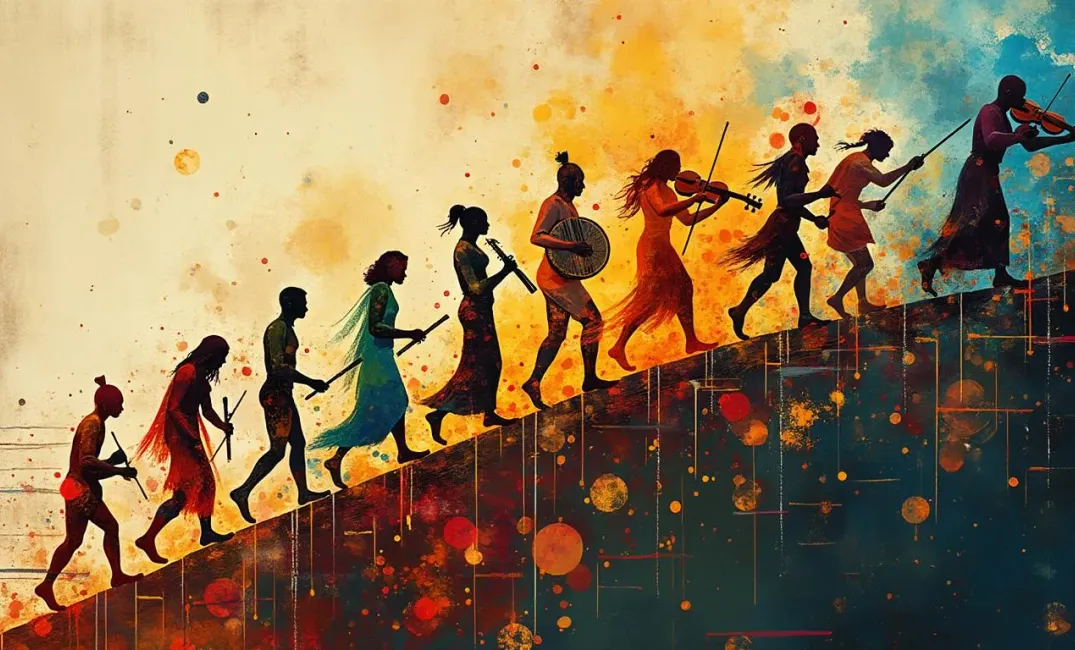Introduction: Music as Humanity's Eternal Companion
"Music is the universal language of mankind." — Henry Wadsworth Longfellow
Music, with its profound ability to evoke emotion, inspire creativity, and foster connections, has accompanied humanity throughout its history. It serves as a reflection of our cultural heritage, social evolution, and artistic expression. Today, we explore the evolution of music, tracing its origins from primal rhythms and chants to the diverse global symphonies that shape our modern experience.
Ancient Echoes: Music's Beginnings
Primitive Rhythms and Melodies
- The Beat of Nature: In humanity's earliest days, music emerged intertwined with the natural world. The rhythmic patterns of rain, the whisper of the wind, and the calls of animals inspired primitive humans to create their own rhythms through clapping, stamping, and vocalizations.
- Simple Instruments: Archaeologists have discovered ancient flutes made from bone and wood, indicating that early humans crafted rudimentary instruments to accompany their nascent musical expressions. These sounds laid the groundwork for communal rituals and storytelling.
Music in Ritual and Ceremony
- Chants and Hymns: Many early societies incorporated music into spiritual and ceremonial practices. Chants and hymns served as a means to communicate with the divine, unify communities, and transmit cultural myths and values.
- Cultural Resonance: Each culture developed unique musical identities, from the haunting throat singing of Siberia's indigenous peoples to the complex polyrhythms of African tribal music, demonstrating music's role in fostering cultural cohesion.
The Classical Foundations: Harmonies of the Ancient World
The Flourishing of Musical Systems
- Greek Music Theory: Ancient Greece's exploration of music is foundational to Western musical theory. Characters like Pythagoras delved into the mathematical relationships underlying musical scales, influencing later harmonics and modes.
- Eastern Traditions: Simultaneously, civilizations in the East, such as India and China, developed intricate musical traditions centered around ragas and pentatonic scales, weaving music deeply into their cultural and spiritual tapestries.
Instruments and Innovation
- Stringed Instruments: The invention of the lyre, kithara, and veena marked significant advancements, allowing diverse melodic expressions. These stringed instruments became central to both artistic and ceremonial compositions.
- Enhanced Melodic Complexity: Innovations in harmony and counterpoint emerged during this era, enhancing melodic complexity and paving the way for future orchestral developments.
Medieval to Renaissance Transformations: Expanding Musical Horizons
The Evolution of Notation and Composition
- Gregorian Chant: The medieval church's adoption of music as a tool for worship led to the development of Gregorian Chant—a foundational form that underscored the power of spiritual music.
- Musical Notation: The advent of musical notation was a transformative leap, enabling composers to write down compositions and thus preserve, teach, and spread musical innovations.
The Renaissance and Humanism
- Polyphony and Harmony: The Renaissance period saw the birth of polyphony, where multiple independent voices intertwined harmoniously. Composers like Palestrina and Josquin des Prez crafted intricate works that illuminated music's evolving sophistication.
- Instrumental Innovations: Renaissance innovation in instruments, such as the harpsichord and viol, expanded the music's emotional range and prepared the stage for the Baroque era's grandeur.
Baroque to Classical Flourishing: The Age of Ornate Expression
The Baroque Era's Grandeur
- Complexity and Ornamentation: The Baroque era embraced elaborate forms and dramatic expressiveness. Composers like Johann Sebastian Bach and Antonio Vivaldi created rich, textured sounds that explored emotional extremes.
- Opera and Oratorio: Opera emerged as a synthesis of music, drama, and stagecraft. With works like Handel's "Messiah," large-scale musical expressions captivated audiences with narratives of human experience.
The Classical Period's Clarity
- Structure and Symmetry: The Classical period heralded a return to melodic clarity and structural balance. Composers like Wolfgang Amadeus Mozart and Joseph Haydn championed simple, elegant symphonies that blended emotion with form.
- Public Concerts and Accessibility: Music became increasingly accessible to broader audiences during this time, with public concerts and printed sheet music contributing to its wider dissemination.
Romanticism to Modern Innovation: Breaking Boundaries
The Romantic Soul
- Emotion and Individualism: Romantic composers like Ludwig van Beethoven and Franz Schubert infused their works with personal emotion and individualism, challenging previous norms with passionate intensity.
- Nationalism in Music: Nationalist composers like Bedřich Smetana and Modest Mussorgsky integrated folk elements, cultivating unique musical identities that inspired pride and cultural consciousness.
20th Century Explorations
- The Age of Experimentation: The 20th century embraced diverse musical paths, from Arnold Schoenberg's atonal compositions to Igor Stravinsky's radical rhythms, reflecting the century's tumultuous and innovative spirit.
- Jazz and Popular Music: Jazz, born from African American communities, reshaped global music with its improvisation and rhythm, while genres like rock, pop, and hip-hop emerged as influential cultural forces reflecting contemporary society.
Digital Era and Global Fusion: Music in the Modern World
Technological Innovations
- Recording and Distribution: Advances in recording technology have democratized music production, allowing artists to reach global audiences, while streaming platforms redefine music consumption.
- Electronic Music: Pioneers like Kraftwerk and Daft Punk introduced electronic music, melding analog and digital sounds, and generating entirely new soundscapes that continue to evolve.
Cross-Cultural Collaborations
- World Music and Fusion: The increasing interconnectedness of cultures has resulted in vibrant musical fusions, with artists blending traditional elements with contemporary genres, reflecting an ever more interconnected world.
- Music as Social Commentary: Modern musicians harness their platforms for social activism, using music as a powerful tool for raising awareness and inspiring change across various global issues.
Conclusion: The Unending Melody of Human Music
"Music expresses that which cannot be put into words and that which cannot remain silent." — Victor Hugo
Music stands as humanity's eternal companion, echoing through time as an indelible manifestation of creativity, expression, and identity. It transcends linguistic and cultural barriers to unite us in shared experiences, reflecting society's myriad facets, from profound joys to collective struggles.
As we continue to explore new musical frontiers, let us cultivate a world where music remains a beacon of hope and connection, harmonizing our diverse voices into a single, splendid cadence that reverberates across the cosmos. In music, the human spirit finds its voice—one that endures, resonates, and cherishes our shared journey through the universe.
INNOVATION, DIGITAL ERA, EVOLUTION, MUSIC, CULTURE, SYMPHONIES, HISTORY

